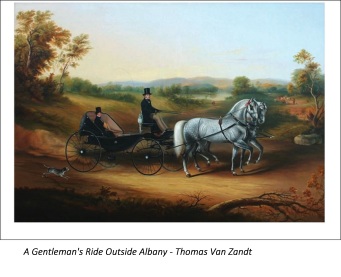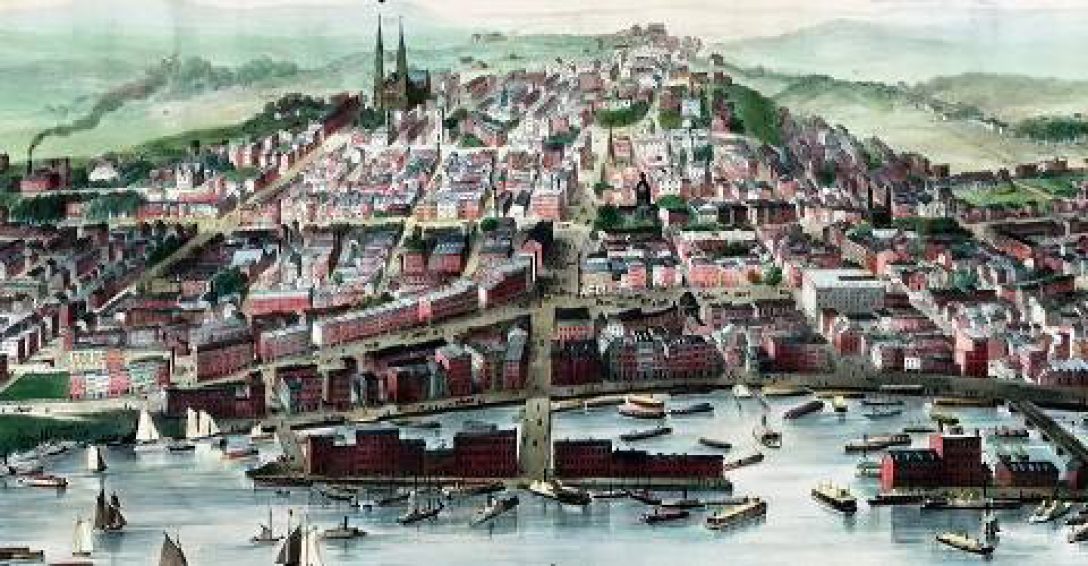
We’re pretty sure you’ve seen at least one of these pictures before. We love them; they’re cheerful and take us back to a time in our history. They were all painted by a father or son from Albany NY – Thomas Kirby Van Zandt (known as Kirby Van Zandt) or his son, William Garrett Van Zandt.
The Van Zandt family had roots in Albany going back to the 1600s; they were among the earliest of the Dutch Settlers. It appears the family lived in the city until about 1780 or so, and then purchased a farm near the New Scotland Plank Road in the town of Bethlehem. (The Van Zandt farm was probably close to what is now the intersection of Whitehall Rd. and New Scotland Ave.) Kirby married, Frances McCormick from the same vicinity. Archibald McCormick came from Scotland in 1787 and operated a farm about where the Academy of Holy Names is today, across from what is now McCormick Rd.
 Kirby was born in 1814 and by time he was 30, in 1844, identified himself as a painter in the city directory. At that time he was living on State St. between Lark and Dove. He sounds like a young man who was fairly confident in his talent and his ability to make a living through his art. The confidence was not misplaced; he was very successful over 40 years. He specialized in horses and farm animals. The area outside Albany was still rural and scattered with hundreds of farm in the surrounding counties,. If you were a fairly well-to-do farmer, you would have the well-known painter Kirby Van Zandt paint your prize winning chicken or bull. Kirby also established himself as a horse-and-carriage painter catering to Albany’s wealthier citizens, like Erastus Corning and Kirby’s brother-in-law, Judge Van Aernum (the painting of the Judge and his sleigh is in the permanent collection of the Albany Institute of History and Art). In later years he specialized in horses and spent time in Saratoga at the horse tracks.
Kirby was born in 1814 and by time he was 30, in 1844, identified himself as a painter in the city directory. At that time he was living on State St. between Lark and Dove. He sounds like a young man who was fairly confident in his talent and his ability to make a living through his art. The confidence was not misplaced; he was very successful over 40 years. He specialized in horses and farm animals. The area outside Albany was still rural and scattered with hundreds of farm in the surrounding counties,. If you were a fairly well-to-do farmer, you would have the well-known painter Kirby Van Zandt paint your prize winning chicken or bull. Kirby also established himself as a horse-and-carriage painter catering to Albany’s wealthier citizens, like Erastus Corning and Kirby’s brother-in-law, Judge Van Aernum (the painting of the Judge and his sleigh is in the permanent collection of the Albany Institute of History and Art). In later years he specialized in horses and spent time in Saratoga at the horse tracks.


 The Van Zandt paintings are referred to as “folk art”, but that isn’t meant to diminish the quality of the paintings. It’s a term that just describes their style. The Metropolitan Museum says these 19th century “ (folk)artists worked principally in the Northeast… Almost all of them favored strong colors, broad and direct application of paint, patterned surfaces, generalized light, skewed scale and proportion, and conspicuous modeling. Most developed compositional formulas that allowed them to work quickly, with limited materials and in makeshift studios.” This describes Van Zandt, moving from farm to farm and painting livestock and chickens in barns. In an era when photography was still a new thing, Van Zandt paintings were widely known in this area as way to preserve the image of your favorite animal.
The Van Zandt paintings are referred to as “folk art”, but that isn’t meant to diminish the quality of the paintings. It’s a term that just describes their style. The Metropolitan Museum says these 19th century “ (folk)artists worked principally in the Northeast… Almost all of them favored strong colors, broad and direct application of paint, patterned surfaces, generalized light, skewed scale and proportion, and conspicuous modeling. Most developed compositional formulas that allowed them to work quickly, with limited materials and in makeshift studios.” This describes Van Zandt, moving from farm to farm and painting livestock and chickens in barns. In an era when photography was still a new thing, Van Zandt paintings were widely known in this area as way to preserve the image of your favorite animal.
But In several instances Kirby went out of his comfort zone; they involve Leland Stanford (Stanford University). Stanford and his wife Jane Lathrop were born in Albany. Although younger than Van Zandt, Stanford clearly respected Van Zandt’s talent and commissioned his work a number of times. In 1878 Stanford invited the noted photographer Eadweard Muybridge to his estate to settle an argument. Muybridge is a photographer important for his pioneering work in photographic studies of motion and early work in motion-picture projection.
 Stanford, who loved horse and horse racing (the shared passion with Van Zandt) believed that at a horse ran all four legs left the ground and at some point it was suspended in the air. Stanford wanted Muybridge to capture this moment in the horse’s stride, an instance imperceptible to the naked eye. Muybridge took a series of photos. The plate itself was fuzzy and unsuitable for publication, so it was left to Van Zandt to strengthen the image. He reproduced the image twice, first as drawing of “crayon and ink wash” dated September 16, 1876, and again as the finished canvas in 1878.
Stanford, who loved horse and horse racing (the shared passion with Van Zandt) believed that at a horse ran all four legs left the ground and at some point it was suspended in the air. Stanford wanted Muybridge to capture this moment in the horse’s stride, an instance imperceptible to the naked eye. Muybridge took a series of photos. The plate itself was fuzzy and unsuitable for publication, so it was left to Van Zandt to strengthen the image. He reproduced the image twice, first as drawing of “crayon and ink wash” dated September 16, 1876, and again as the finished canvas in 1878.
Van Zandt also painted one of the few pictures of Leland Stanford, Jr., (when he was about 12 in 1881), 3 years before his too young death from typhoid when he was 15. It’s a picture of a bundled up boy and his dog near a frozen lake where people are skating, so it was probably painted in Albany on a Stanford family trip back East. It may be set in Washington Park.
The Cantor Museum at Stanford University includes six paintings by Kirby Van Zandt and one by his son William. They include the Leland, Jr painting and Jane’s childhood home – somewhere on Washington Ave. between Dove and S. Hawk. (There are several addresses for their homes in the 1840s city directories so we’ve been unable to establish the exact location.) He also painted Jane’s father, Dyer Lathrop and Leland Sr,’s childhood home on Central Ave. just beyond the Albany city line. Of course he did several pictures of Stanford’s favorite horse, “Abe Edgington”.




As Kirby’s success grew, and he married and had a family, he moved to Knox St. near Madison, where he ultimately had his home and a studio in the building next door. But as Washington Park grew the Van Zandt properties were acquired for Park expansion. The family located to the farm on New Scotland where Kirby spent his final years before his death in 1886. The area was then known as Hurstville, and it must have been quite agreeable, since there was a horse racing track located about where Mater Christi church and school are today (the Pleasure Park trotting track existed from the 1860s to the early 1900s).
 This brings us to his son, William who followed in his father’s footsteps. William was born in 1867 while the family lived in Albany. He had his father’s talent and his love of horse and horse racing. William was actually a “starter” for the Saratoga races and a member of Albany Driving Club. (The Driving Club met at Woodlawn Park – where Albany Academy for Boys is currently located and held trotting horse races.) In addition to painting, William held several jobs, including Albany City vital statistic registrar and then assistant superintendent for art in the Albany public schools. He lived at the family farm in New Scotland, then in the city at several uptown locations and then spent the last 20 or so years in Guilderland. He passed away in 1942.
This brings us to his son, William who followed in his father’s footsteps. William was born in 1867 while the family lived in Albany. He had his father’s talent and his love of horse and horse racing. William was actually a “starter” for the Saratoga races and a member of Albany Driving Club. (The Driving Club met at Woodlawn Park – where Albany Academy for Boys is currently located and held trotting horse races.) In addition to painting, William held several jobs, including Albany City vital statistic registrar and then assistant superintendent for art in the Albany public schools. He lived at the family farm in New Scotland, then in the city at several uptown locations and then spent the last 20 or so years in Guilderland. He passed away in 1942.


Both Van Zandts were prolific artists and their painting styles are similar (we read somewhere that William always include 3 birds somewhere his paintings – we can find in some and not others). It’s probable the Van Zandts painted hundreds of paintings in their lifetimes. They’re in the collections of the Bennington Museum and the Fenimore Art Museum; many are in private collections and other smaller galleries. Sometimes you can find a show at a local museum, but folk art has never really caught on in a big way, which we think is a shame. It can tell us a lot about the lives of the people and objects who were its subjects and the people who made the art.









Copyright 2021 Julie O’Connor

